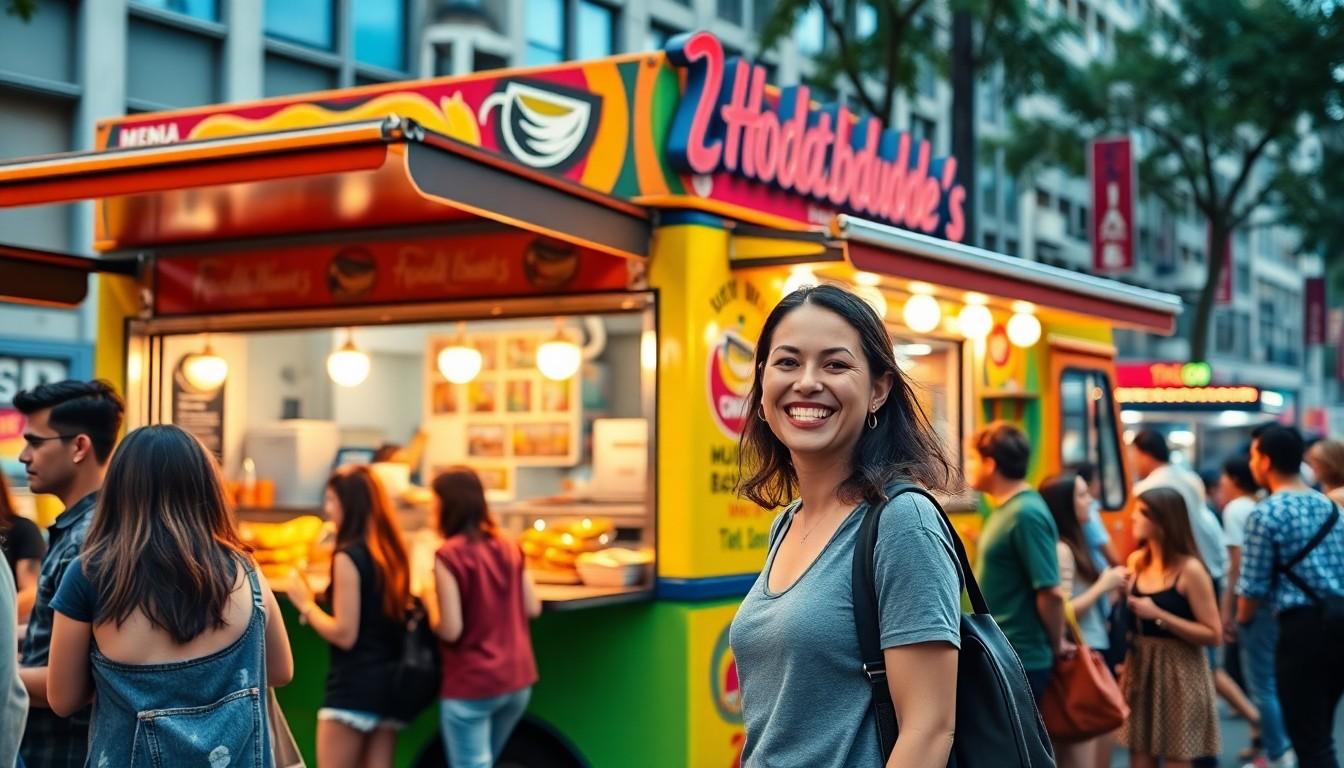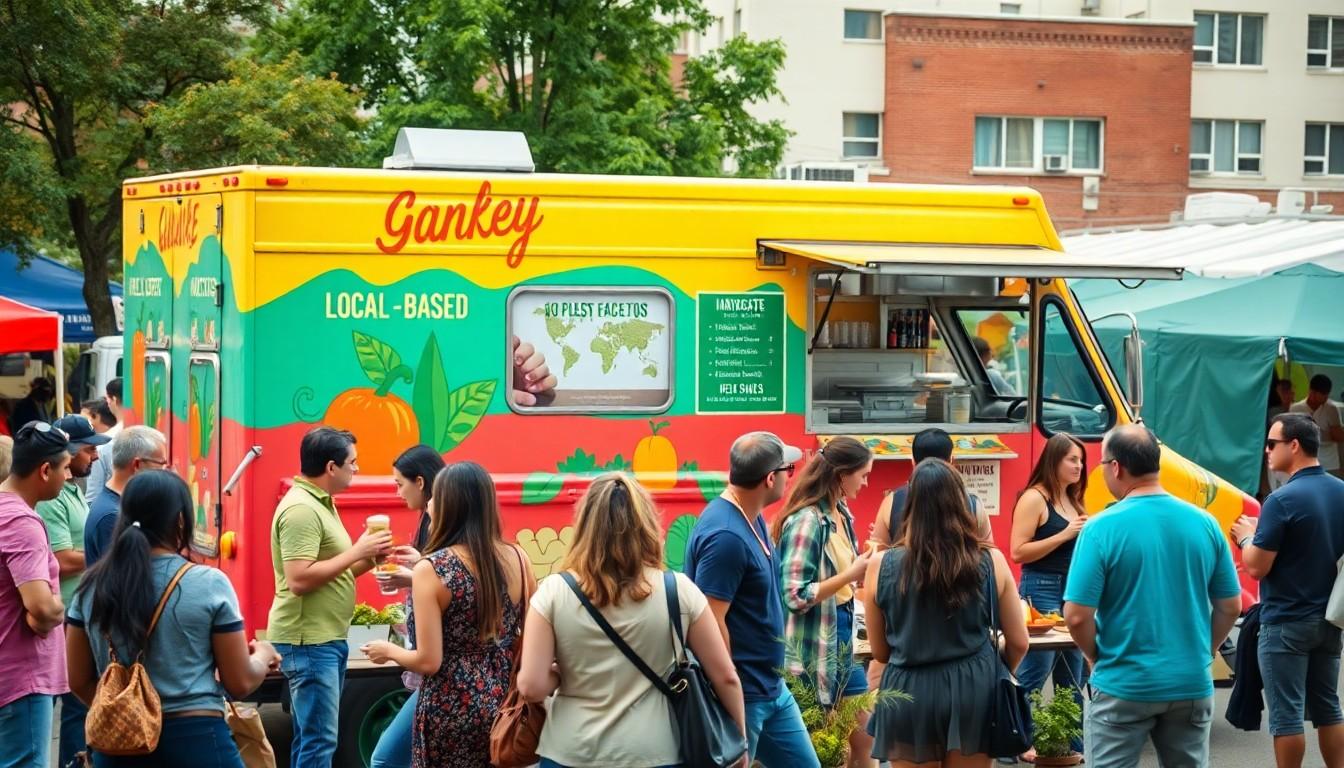Physical Address
304 North Cardinal St.
Dorchester Center, MA 02124

In the bustling world of food trucks, success isn’t just about whipping up tasty tacos or gourmet grilled cheese. It’s about riding the wave of consumer trends that can turn a humble mobile kitchen into a culinary sensation. Picture this: a line of hungry customers eagerly awaiting their turn, all because the food truck has tapped into what diners really want.
Consumer trends significantly impact food truck success. Popularity often hinges on menu diversity, with options appealing to various dietary preferences. Consider offering vegan, gluten-free, or organic choices to attract a broader customer base.
Location plays a crucial role in visibility and foot traffic. Busy urban areas, popular events, or local festivals create prime opportunities for exposure. Successful trucks strategically position themselves in high-traffic locations to maximize sales.
Social media engagement drives customer interest and loyalty. Food trucks that actively showcase their offerings on platforms like Instagram or Facebook thrive. Engaging content, including vibrant food photos and customer interactions, helps build a loyal following.
Sustainability practices resonate with modern consumers. Trucks using eco-friendly materials or sourcing local ingredients tend to attract conscious diners. Emphasizing these practices can enhance brand reputation and appeal to a growing market segment.
Pricing strategies also significantly influence customer decisions. Competitive pricing without compromising quality attracts budget-conscious diners. Special deals or loyalty programs can further enhance customer retention.
Lastly, the overall dining experience matters. Cheery branding, friendly service, and a unique atmosphere contribute to a memorable visit. Ensuring a positive experience encourages customers to return and recommend the food truck to others.
Understanding these consumer trends enables food truck owners to adapt and innovate, ensuring ongoing success in a competitive market.

Current consumer preferences heavily influence food truck success. Owners must understand these trends to thrive in a competitive landscape.
Health consciousness shapes dining choices. Consumers increasingly seek nutritious options that align with wellness goals. Many opt for meals rich in whole foods, lean proteins, and plant-based ingredients. Food trucks can appeal to this demand by offering balanced menus featuring salads, grain bowls, and fresh juices. Additionally, labeling ingredients clearly enhances transparency. By catering to dietary needs, such as gluten-free or dairy-free options, food trucks attract a broader customer base.
Sustainability practices resonate with today’s consumers. Various patrons prioritize environmentally friendly choices and seek out food trucks using local and seasonal ingredients. Sourcing supplies from eco-conscious vendors demonstrates commitment to the planet and boosts brand appeal. Using biodegradable packaging also increases consumer trust. Moreover, implementing waste-reduction initiatives, like composting, showcases responsibility. These sustainable practices strengthen the connection with environmentally aware diners.
Unique and diverse cuisine enhances food truck offerings. Diners crave new experiences that reflect flavors from around the world. Food trucks can stand out by introducing fusion dishes or regional favorites, such as Korean tacos or Caribbean jerk chicken. Engaging with local cultures and communities enriches the menu and attracts adventurous eaters. Exclusive specials or limited-time offerings keep customers intrigued and encourage frequent visits. Connecting with a variety of tastes fosters loyalty and attracts a diverse clientele.
Technological advancements significantly shape consumer behavior in the food truck industry. They create opportunities for food trucks to enhance customer engagement and streamline operations.
Mobile ordering revolutionizes the way customers interact with food trucks. By offering apps or partnering with existing platforms, food trucks enable diners to place orders in advance. This convenience reduces wait times and allows customers to enjoy their meals without hassle. Payment options are vital; secure digital payment methods like Apple Pay or Google Wallet attract tech-savvy consumers who prefer cashless transactions. Ensuring a seamless ordering and payment process enhances customer satisfaction and encourages repeat visits.
Social media serves as a powerful tool for food trucks to connect with their audience. Engaging content on platforms like Instagram and Facebook helps showcase menu items, promotions, and events. Visual elements, such as high-quality photos, resonate with potential customers and drive interest. Active social media presence encourages user interaction, like sharing experiences and leaving reviews. Additionally, targeted online marketing campaigns can reach specific demographics, boosting visibility and attracting new customers. Leveraging these digital tools positions food trucks favorably amid a competitive landscape.
Location significantly influences a food truck’s success. High-traffic areas attract more customers. Busy urban spots, festivals, and local events provide ideal settings for food trucks to maximize visibility. The flow of pedestrians in these areas often translates into sales.
Accessibility matters equally for potential patrons. Food trucks located near popular attractions or workplaces generate consistent foot traffic. Additionally, easy access to parking and dining areas increases the likelihood of customer visits. Consumer convenience encourages repeat patronage.
Proximity to public transportation hubs enhances accessibility. When food trucks are near bus stops or train stations, they tap into a larger audience. Commuters looking for quick meal options favor such convenient locations, boosting sales.
Visibility plays a crucial role in a food truck’s success. Trucks positioned near well-lit areas or popular storefronts attract attention. Bright branding and eye-catching designs draw in curious customers who may not have specifically sought out the truck.
Understanding local regulations enhances location strategy. Knowing permit requirements and zoning laws prevents potential setbacks. Successful food trucks ensure compliance while selecting locations that align with their target audience.
Event participation is another impactful factor. Setting up at community events or food festivals allows trucks to reach new diners. Such settings provide opportunities for exposure, sampling, and building a loyal customer base.
Traffic patterns warrant analysis to identify optimal operating hours. Busy lunch spots may benefit from late-morning openings, while dinner shifts cater to evening throngs. Adjusting hours to match demand improves sales potential.
Differentiating offered cuisine types can further enhance a food truck’s location strategy. Specialty trucks, such as vegan options or gourmet tacos, attract specific clientele. They complement established dining cultures and fill gaps within local food scenes.
Customer experience plays a crucial role in the success of a food truck. Engaging atmospheres draw patrons in and create memorable dining experiences. While cheerful branding attracts attention, friendly service ensures patrons feel welcomed. Inviting interactions leave lasting impressions and encourage customers to return.
Building a connection with customers enhances loyalty. Regular updates on social media platforms foster community engagement. Sharing behind-the-scenes content humanizes the brand, allowing customers to relate to the food truck. Engaging with followers through comments and messages creates a two-way conversation that strengthens customer relationships.
Utilizing feedback also drives improvements. Actively seeking reviews helps identify areas needing attention. Adapting menus based on customer preferences signals responsiveness, demonstrating that the food truck values input. This responsiveness enhances the overall dining experience.
Unique events can increase engagement as well. Hosting themed nights or collaborations with local businesses generates buzz. These events create excitement and leverage the local community’s involvement, attracting new clientele. Participating in food festivals broadens visibility, reaching potential customers who may not have encountered the truck otherwise.
Technology further influences customer engagement. Implementing loyalty programs encourages repeat visits through rewards. Mobile ordering systems streamline the process, minimizing wait times and enhancing convenience. Convenient digital payment options simplify transactions, appealing to tech-savvy consumers.
Emphasizing sustainability strengthens brand appeal among modern diners. Showcasing eco-friendly practices, such as using biodegradable packaging, resonates with environmentally conscious patrons. Engaging in community initiatives highlights a commitment to local values, fostering a positive image.
Ultimately, delivering an exceptional customer experience and actively engaging patrons create a strong foundation for a successful food truck business.
Understanding consumer trends is essential for food truck success. By adapting to preferences for diverse menus and sustainable practices, food trucks can attract a loyal customer base. Strategic location choices and effective use of social media further enhance visibility and engagement.
Creating memorable dining experiences through friendly service and unique offerings fosters repeat visits. Embracing technology like mobile ordering can streamline interactions and improve customer satisfaction. Ultimately, those who stay attuned to the evolving desires of diners will find lasting success in the competitive food truck market.